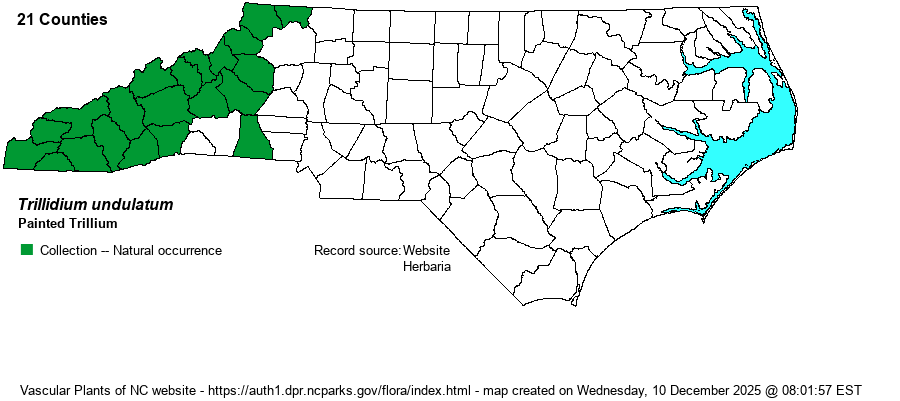| Author | Floden & Schilling | |
| Distribution | Occurs throughout the Mountains, and barely into the higher elevations of the western Piedmont, such as the South Mountains.
This is a Northeastern species of trillium, ranging from N.S. and Que. to Ont., WI(?) and MI; south through New England and NY, and then southward in the Appalachians to northern GA. It is practically absent west of eastern OH and eastern TN. | |
| Abundance | Fairly common in the higher elevations of the Mountains, mainly over 4,000 feet. Uncommon downward to perhaps 3,000 feet, but very rare at lower elevations. This is a widespread species in the NC Mountains, known from all counties, but it does not generally grow in large stands as do many other species. Typically scattered individuals are found, but over a wide array of habitats. | |
| Habitat | This is one of the very few trilliums in the state -- along with T. catesbaei -- that favors acidic soil as opposed to strongly circumneutral soil. It is found in cold to cool forests, often under conifers or mixed hardwoods and conifers -- such as Red Spruce (Picea rubens) or hemlocks (Tsuga). It can be found in Acidic Cove Forests, spruce-hardwood stands, Northern Hardwood Forests, and other montane stands that have a cool microclimate. It often grows on slopes near evergreen rhododendrons -- Rhododendron maximum and/or R. catawbiense. |
| Phenology | Blooms from late April into May, and fruits from late July into August. | |
| Identification | This is the easiest montane species of trillium to identify, one that even beginners can tell from others. It grows about 1-1.5 feet tall, but the three large leaves are a dark green as opposed to a rich bright green of all other non-mottled species. Each leaf has a short petiole, about 1/2-inch long. The single flower has a rather short but erect stalk, such that the flower is held slightly above the leaves. Each of the three white petals has a distinctive red-V band at the base, marking this species when immediately seen in bloom. No other trillium in our region is marked on the petals. A walk in the higher mountains often will produce a few individuals. Because the leaves are a dark green, and the plants often occur under conifers and near evergreen rhododendrons, you should be able to identify the species even if not in bloom. Also, you likely will see a few plants with just a single leaf, an immature one that should produce three leaves and a flower in upcoming years. | |
| Taxonomic Comments | See Floden & Schilling paper in JBRIT 12: 477 for the transfer from genus Trillium to Trillidium.
| |
| Other Common Name(s) | Striped Wake-robin, Painted Wake-robin | |
| State Rank | S4 | |
| Global Rank | G5 | |
| State Status | | |
| US Status | | |
| USACE-agcp | | |
| USACE-emp | | |

